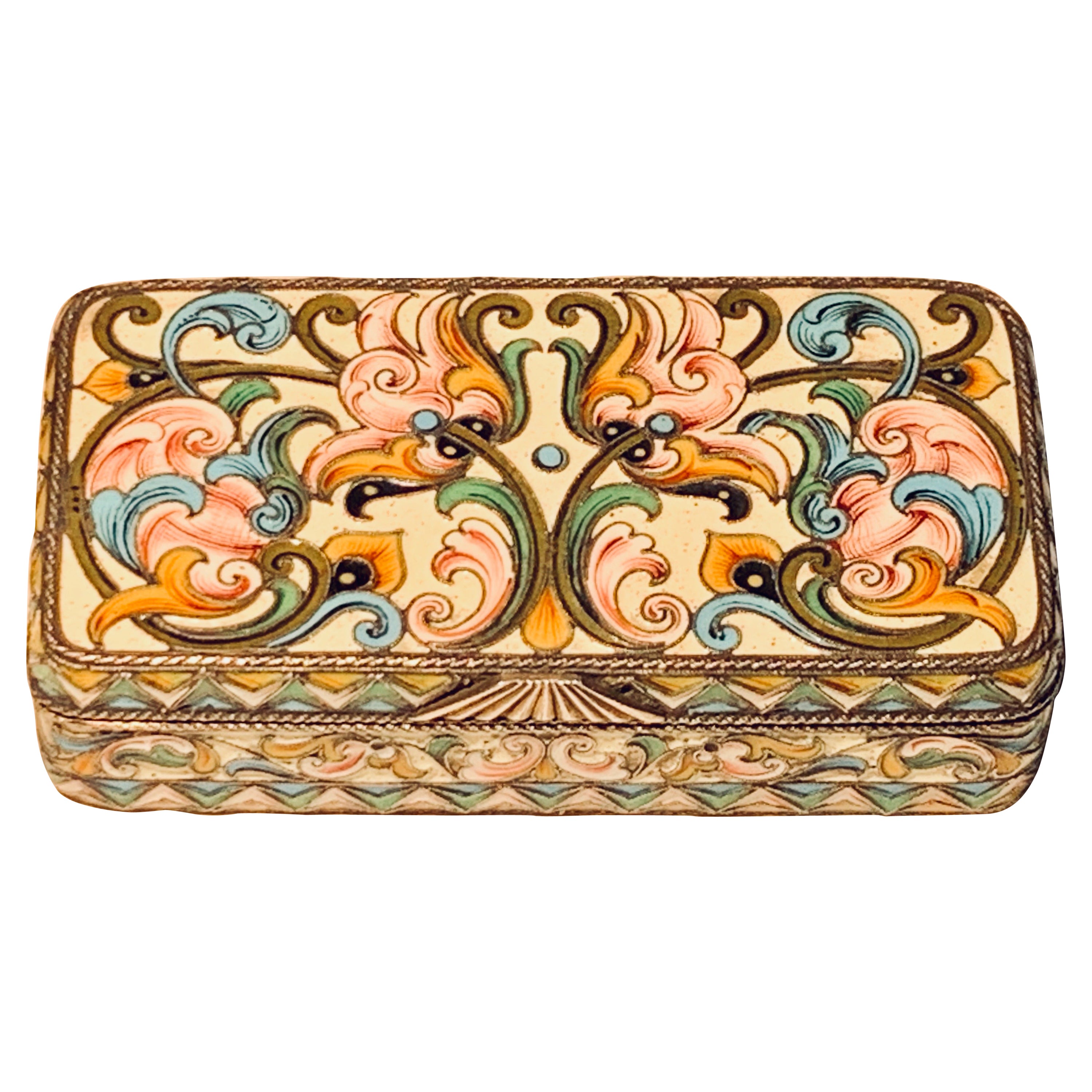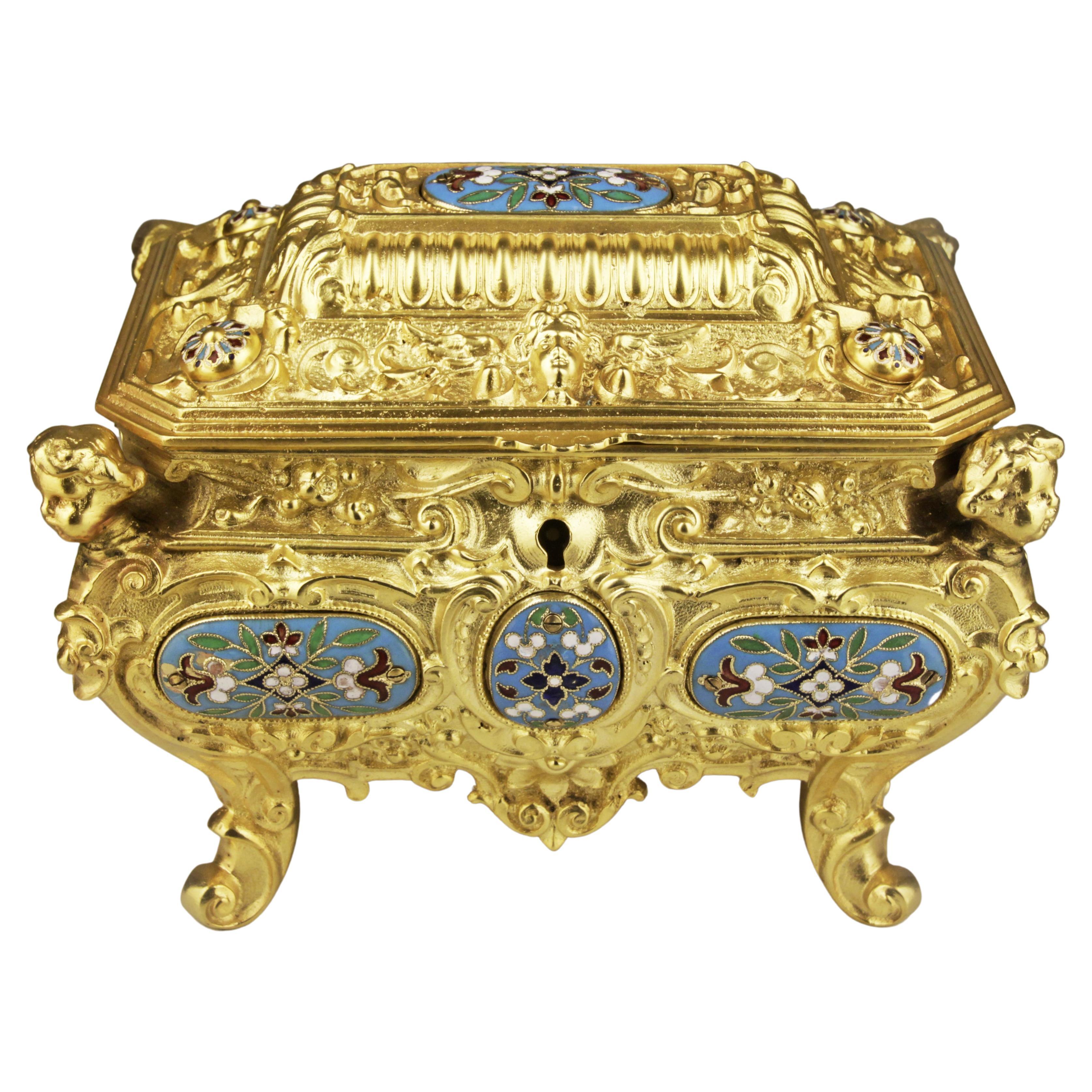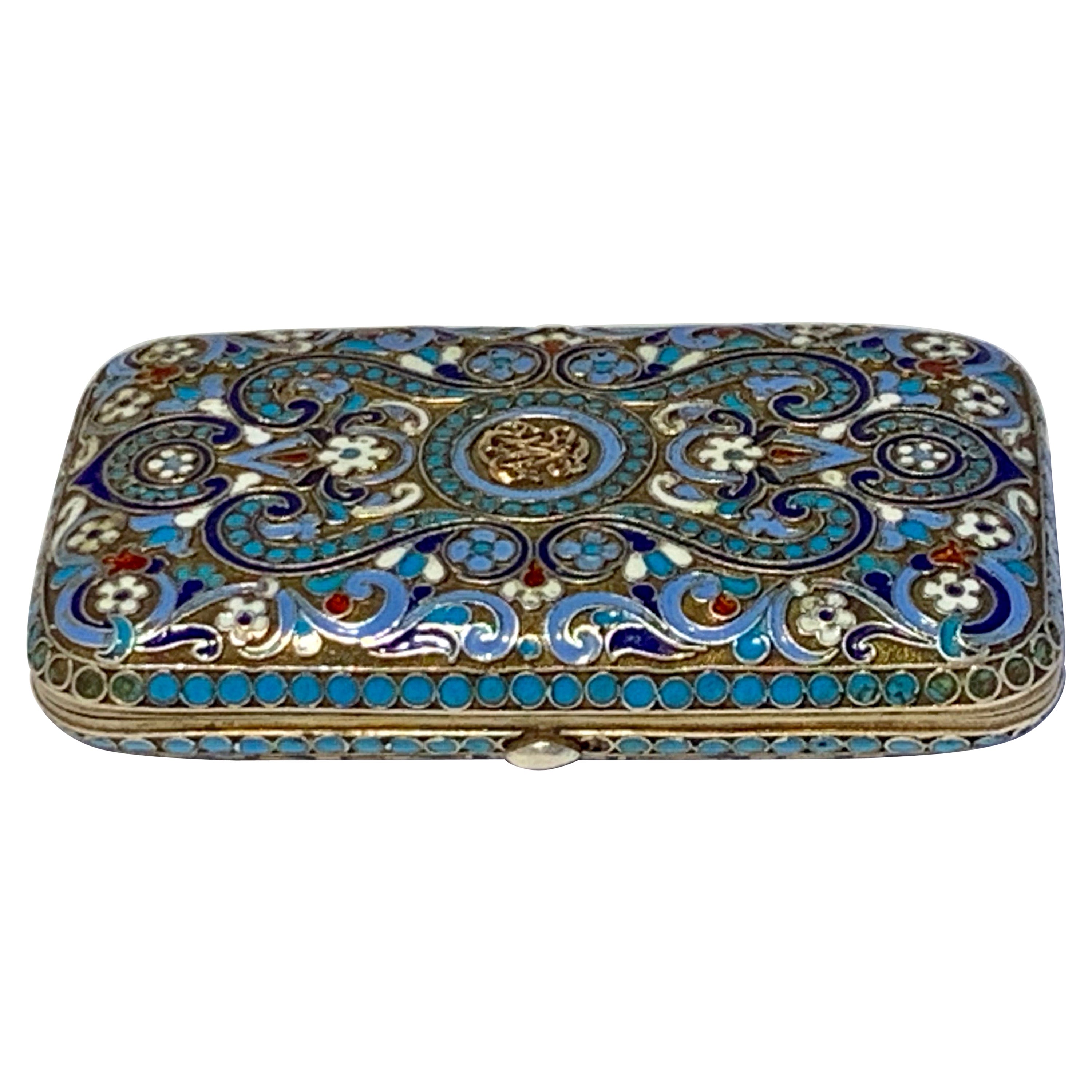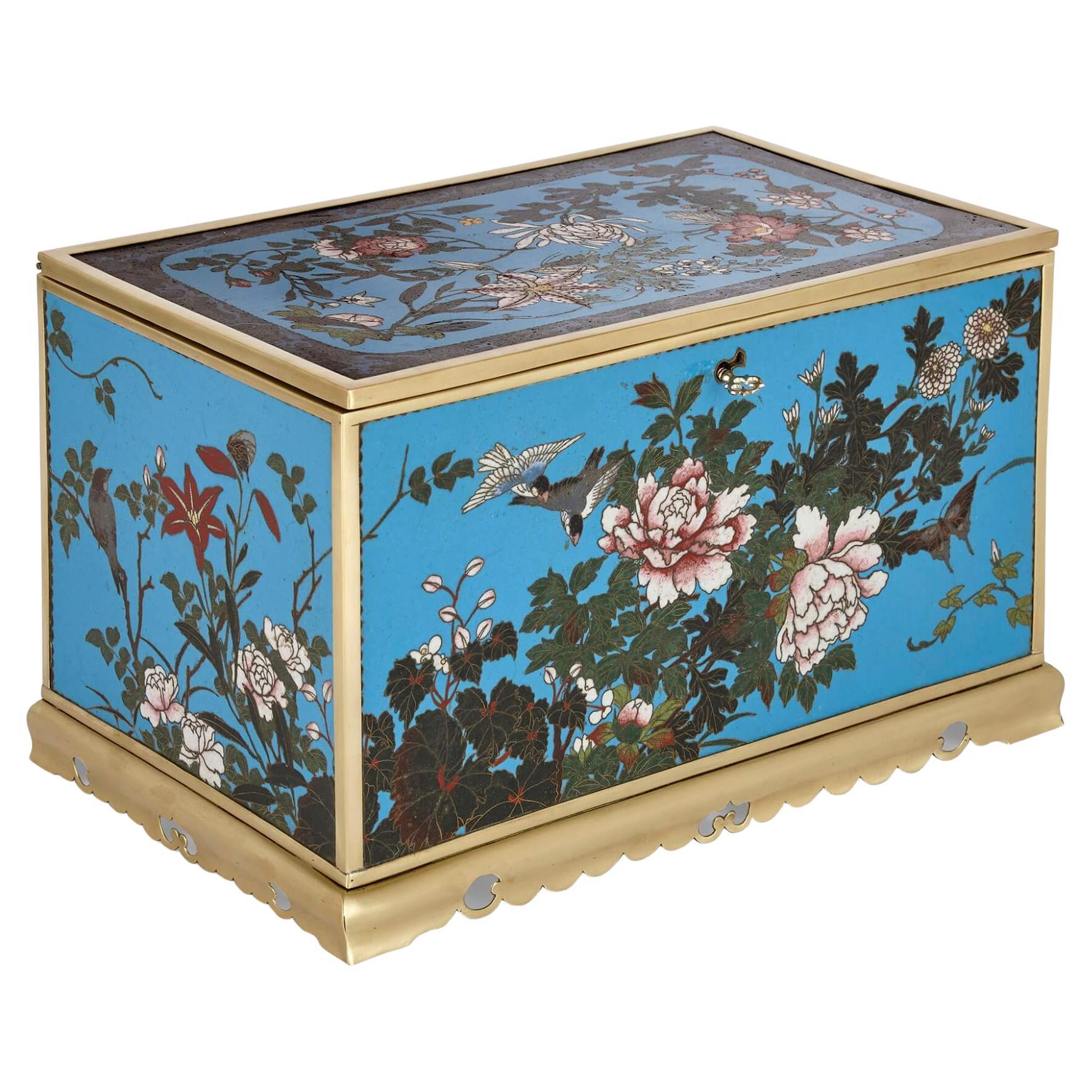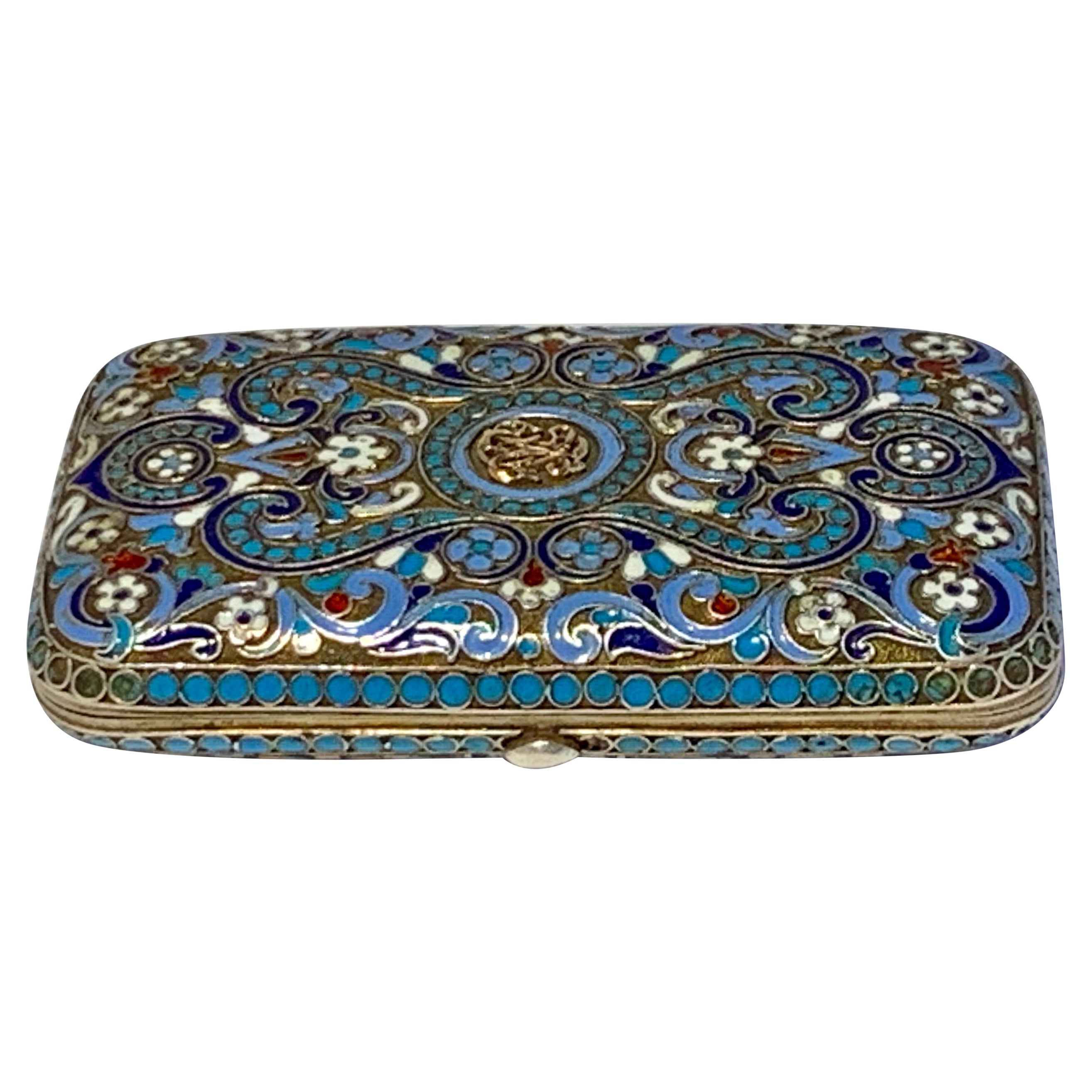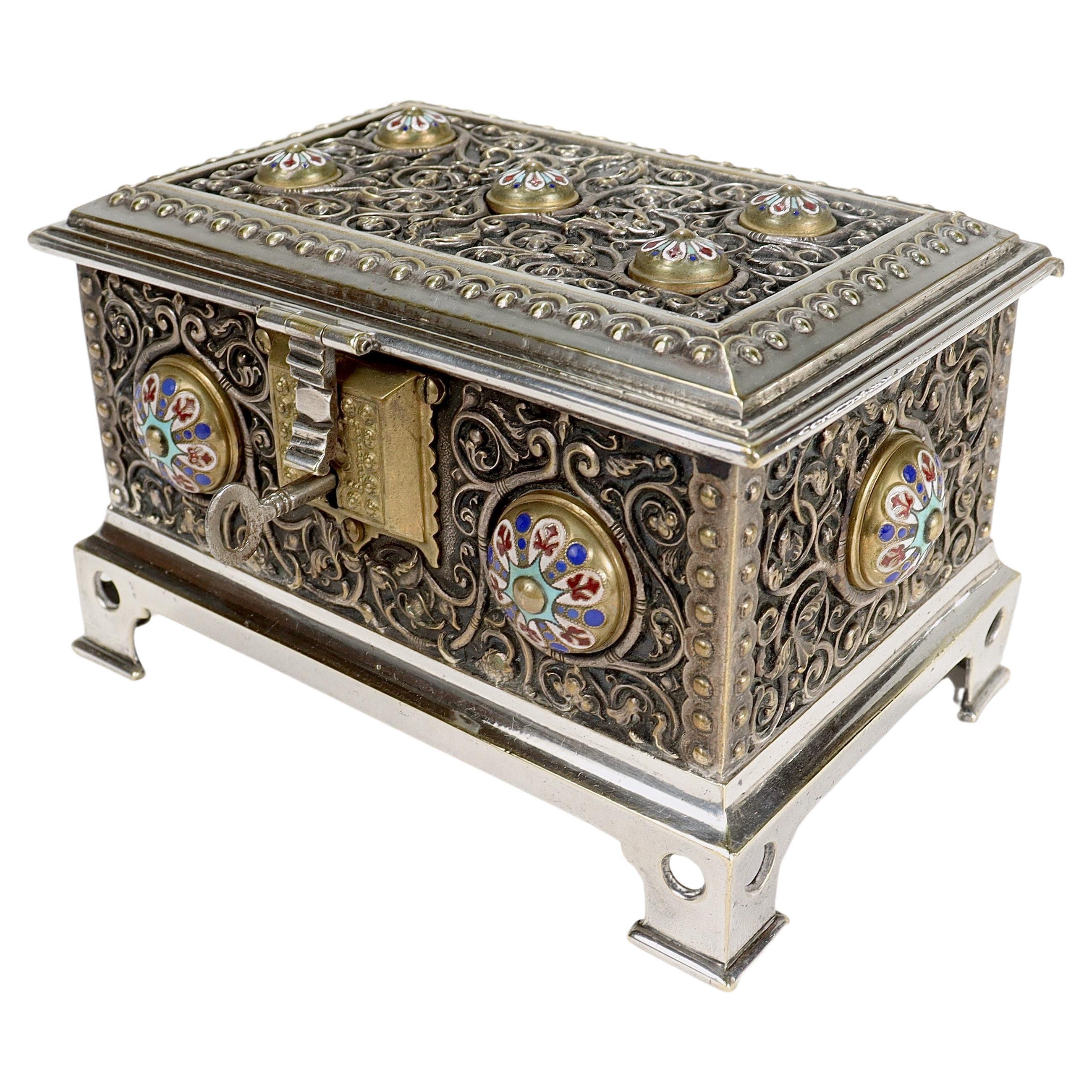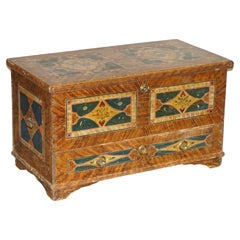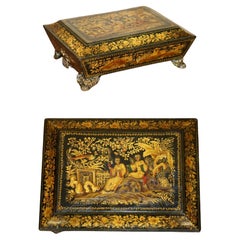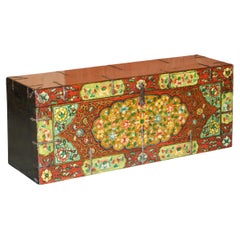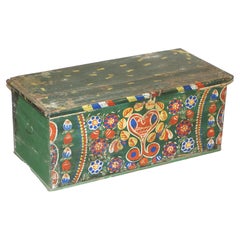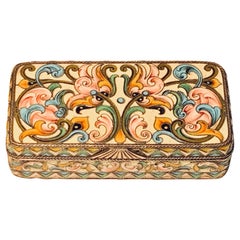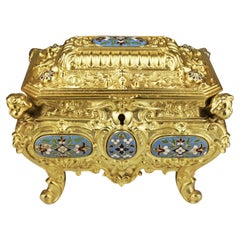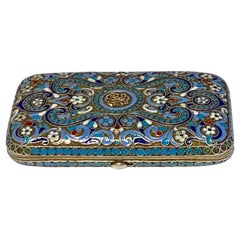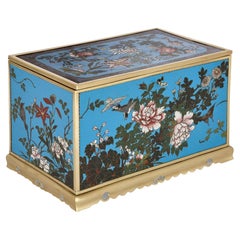Items Similar to Russian Silver Pavel Ovchinnikov & Ivan Khlednikov Gilt Cloisonné Enamel Casket
Want more images or videos?
Request additional images or videos from the seller
1 of 21
Russian Silver Pavel Ovchinnikov & Ivan Khlednikov Gilt Cloisonné Enamel Casket
$19,375.95
$27,679.9330% Off
£14,000
£20,00030% Off
€16,555.05
€23,650.0730% Off
CA$26,521.42
CA$37,887.7430% Off
A$29,705.39
A$42,436.2730% Off
CHF 15,456.70
CHF 22,08130% Off
MX$360,769.88
MX$515,385.5530% Off
NOK 195,951.71
NOK 279,931.0130% Off
SEK 184,895.03
SEK 264,135.7630% Off
DKK 123,524.22
DKK 176,463.1730% Off
Shipping
Retrieving quote...The 1stDibs Promise:
Authenticity Guarantee,
Money-Back Guarantee,
24-Hour Cancellation
About the Item
We are delighted to offer for sale this stunning and very rare full sized Imperial Russian 1891 Cloisonné enamel casket box made from solid silver with gold gilding by the highly coveted Pavel Ovchinnikov whilst he worked with Ivan Khlebnikov complete with the Romanov Eagle silver stamp for the last Czar and Tsarina of Russia
Attached you can see a screenshot of some lots due for sale on the 26th November at Christie's, I for one will be very excited to see the end results
For those die-hard Russian silver collectors out there this piece is just about as rare and important as they come, it confused me, to begin with, because its clearly made by Pavel Ovchinnikov, his other works of this kind are know and easily found with a little internet research, however it is stamped for Ivan Khlebnikov
The import extract is as follows "The growing fame helped the factory to receive the honorary orders. Together with the firm "Nicols and Plinke", as well as with jewellers Pavel Akimovich Ovchinnikov (1830–1888) and Ivan Ekimovich Morozov (1825-1885) he was involved in the renovation of the Palace silver dinner sets. "
The two silversmiths were working at the same time, in the same pallet of materials and on the same projects, this link inexplicably solves the mystery of how two of the three greatest silversmiths in Russia (Faberge being the third of course) came to collaboration
The casket itself is an exceptionally rare find, I’ve only ever seen one other of this type come up for auction, it was just over 10 years ago in Christie's, it was half the size, you can see on 1stdibs for the current market value of Ovchinnikov pieces, they are around the £15-£20,000 for small objects and £20-£40,000 for medium to large objects like this
The piece is solid silver with gold gilding and cloisonné polychrome enamel, it’s detailed with scrolls and stylised flowers on stippled grounds within geometric borders, the two handles formed as cockerels and its finished with clawed ball feet
The box is fully and clearly hallmarked A.O 1891, 84 with a rearing horse, then Khlebnikov in Russian Cyrillic below the Imperial warrant which as mentioned was awarded to Khlebnikov by the then Czar Nicholas II (18 May 1868 - 17th July 1918) and his wike the Tsarina Alexandra Feodorovna (6 June 1872-17th July 1918)
Condition wise the piece to my eyes and hands looks amazing, the finish around one of the claw feet at the top looks slightly different to the others so it may have possibly been repaired at some point, otherwise its museum quality
Dimensions and weight to follow
Please note all measurements are taken at the widest point.
Pavel Ovchinnikov:
Appointed official purveyor to Tsar Alexander III (1865), King Victor Emmanuel II of Italy (1873), Grand Duke Mikhail Nikolaevich (1878) and King Christian IX of Denmark (1888). Awarded the Légion d’honneur (1867) and the Order of the Iron Crown (1873). Founded a school for 130 goldsmiths and silversmiths (1871). Opened a factory and shops in St Petersburg at 35 Bolshaya Morskaya Street (1873) and the former premises of Sazikov at 29 Bolshaya Morskaya Street (1900). Member of the Moscow City Duma (1876–88). Died and buried at Kalitniki (Moneybags) Cemetery in Moscow (1888), where his work was continued by his sons Mikhail, Alexander, Pavel and Nikolai (1888–1917).
Contributed to exhibitions (from 1865). Contributed to the Pan-Russian Manufacturing Exhibition in Moscow (1865, gold medal), Exposition Universelle in Paris (1867), Weltausstellung in Vienna (1873), Pan-Russian Exhibition of Art and Industry in Moscow (1882, silver medal), Exposition Universelle in Paris (1900), Princess Dagmar – Empress Marie Feodorovna at Christiansborg Palace in Copenhagen (1997), Golden Treasure Trove of the Russian Museum at the Russian Museum in St Petersburg (1998), Treasures of the Moscow Kremlin at the Alexander Radischev Museum of Art in Saratov (2005) and Samara Regional Museum of Art in Samara (2005–06), Empress Maria Fedorovna: A Life and Fate at the Federal Archives Exhibition Hall in Moscow (2006), Russian Silver of the 18th–20th Centuries from the Collection of the Moscow Kremlin Museums at the Samara Regional Museum of Art in Samara (2007–08), Enamels of the World 1700–2000 from the Khalili Collections at the Hermitage Museum in St Petersburg (2009–10), Russian Silver (18th to Early 20th Centuries) at the Ivan Shemanovsky Museum and Exhibition Complex of the Yamalo-Nenets Autonomous District in Salekhard (2010–11), Golden Age of Russian Jewellery Art at the Vladimir-Suzdal Museum Complex of History, Architecture and Art in Vladimir (2010–11), Russian Jewelry – Traditions and Modern Day at the Estet Jewelry House in Moscow (2011), Splendour and Glory: Art of the Russian Orthodox Church at the Hermitage Amsterdam in Amsterdam (2011), Gold: Metal of Gods and King of Metals at the History Museum in Moscow (2012), Fabergén aika at the Museum Centre Vapriikki in Tampere (2006), Il gioielliere degli ultimi Zar at La Venaria Reale in Turin (2012), World of Fabergé at the Shanghai Museum in Shanghai (2012–13), Fabergé: Legacy of Imperial Russia at the Hong Kong Heritage Museum in Hong Kong (2013) and Fabergé: A Brilliant Vision at the Houston Museum of Natural Science in Houston (2013).
Khlebnikov factory The history
The founder of the dynasty, Ivan Petrovich Khlebnikov was born in 1819 in Moscow, in the burgher family in Luzhniki region. Practically nothing was known about his works until he established a private firm. It might be possible that the son followed up the father’s business. Piotr Khlebnikov had been enlisted in merchantry since 1832 and was the owner of the trading and manufacturing jewellery establishment. Very little is known about the history of the firm.
According to some researchers, Ivan Petrovich was working in St. Petersburg until 1867. He founded the manufacturing firm in Moscow in 1870. He wrote, "being engaged in the silver and gold articles trading for about forty years, I opened a manufactory of my own...» It is possible that in the 1830s, I. Khlebnikov already owned a shop, but he opened the factory later, at the turn of 60-70s of the 19th century. One hundred people were working at the factory and the turnover of production was 56 thousand rubles in 1871. Since that time, the firm began to grow. Several shops were opened: a store at the Kuznetski Bridge in the house of Solodovnikov, a store on Ilijnskaya street in the house of Novgorod courtyard in the silver row. New shops were opened in other cities: in Saint Petersburg in Nevsky Prospekt and in the main line of the Nizhny Novgorod fair.
The factory was well equipped with the latest technique for all types of works, produced articles in all major styles of the second half of the 19th - early 20th century. The Russian and Modern styles were very popular, as well as various historic styles: the Neo-Baroque, Neo-Rococo, and Neo-classicism styles.
In addition to the main factory with special space for painting and sculpture, about 300 workers were employed; there were special workshops for stone cutting, metal processing, etc. Khlebnikov matured as a jeweller in the period of his close collaboration with the Petersburg firm Gasse.
He regularly participated in various exhibitions. For the first time, Ivan Petrovich exhibited his works together with P. A. Ovchinnikov at the Moscow Polytechnic exhibition in 1872. His works were awarded with two large gold medals.
The growing fame helped the factory to receive the honorary orders. Together with the firm "Nicols and Plinke", as well as with jewellers Pavel Akimovich Ovchinnikov (1830–1888) and Ivan Ekimovich Morozov (1825-1885) he was involved in the renovation of the Palace silver dinner sets.
Khlebnikov factory produced for Anichkov and Gatchina palaces 160 new items of The Golden Set made by artists G. F. Eckart and J. G. Blom in 1759-1784; The missing items were made for other sets of these same palaces; The Dessert set with the monogram of Catherine II, donated by Prince G. Potemkin was renovated; The Orlovsky dinner set was manufactured in 1772-1776; The Fourth Camping set was made. It was submitted to the Imperial Palace in 1797 as a gift from merchant Glazunov; Coffee pots, teapots, sugar bowls, milk jugs, teaspoons and spoons for salt, quadrangular flat serving dishes for several dinner sets from the Winter Palace on the old models were manufactured according to the old models.
From the first years of its existence, the factory gained the right to be ranked as the Supplier of the Imperial family due to high quality of the produced silver and gold articles. Khlebnikov supplied with his production Grand Dukes since 1869. He was titled the supplier of the court of the Grand Duke Konstantin Nikolayevich in 1869, continually had been receiving orders for the wardrobe of Her Majesty the Empress Maria Alexandrovna since 1873. This fact was an honorary distinction and evidenced about his good reputation among the customers. Khlebnikov’s jewellery came to fashion. Having achieved recognition, Ivan dreamed of the most honourable title "The Supplier of the Imperial Court". He wrote in 1875, "the right to be called the Supplier of the court... will serve me and my heirs, the successors of my business – the most invaluable encouragement to continue honest labor and precious estimation of my firm". Finally, in 1879 he received the long-awaited title of 'The Supplier of Russian Imperial Court" and the right to depict the national armorial bearings on the factory sign.
The firm of Khlebnikov was awarded with the title of "The Supplier of the Danish, Dutch and Serbian Kings’ Courts", as well as "THe SUpplier of Montenegrian Prince Court". Ivan Petrovich died in 1881, at the age of 62, was buried in the Spaso-Andronikov monastery. His sons inherited his business: Michael, Alex, Nicholas and Vladimir. 300 artisans were working at their factory "Partnership I. P. Khlebnikov, Sons & Co” in 1882. There were the goldsmiths, coppersmiths, chasers, haberdashers, enamellers and filigree artists. They represented all sectors of goldsmith. There were specialized workshops, the number of workers in which amounted 1,000 people. The fame of the factory and its authority after the death of Ivan Petrovich did not diminished. Together with the best Moscow jewellers-manufacturers, the firm participated in the decoration of the temple of Christ the Savior. The Khlebnikov’s family created nearly 50 religious articles according to their sketches and drawings: ostensories, chalices, Holy-water bowls, and jugs for Holy water, incense burners, serving dishes, and icon-lamps.
Nevertheless, the mass-market production mainly provided the financial wellbeing of the company. Large quantity of medium-priced silver objects, dinnerware, cutlery and jewellery was produced. A trading-industrial enterprise under the name Partnership for production of silver, gold and jewellery “I. P. Khlebnikov, Sons and Co” was established on the basis of the company. It expanded and assimilated well-known jewellery shops and factories owned by Sazikov, both in Moscow and St. Petersburg. The catalog of M. M. Postnikov “Gold and Silver Manufacturing of the 15th-20th centuries" narrated that by 1897 the factory of brothers Khlebnikov possessed two steam engines and one steam boiler. They manufactured production for the total amount of 172 372 rubles.
The achievements of the firm "I. P. Khlebnikov, Sons & Co" were distinguished in the development of Russian jewellery”. Ivan Petrovich was awarded with a bronze medal on the Anninskaya ribbon and five Golden medals. His elder son, Mikhail Ivanovich was awarded with the order of Stanislaus of the third degree in 1881 and was ranked as an honorary citizen of St. Petersburg in 1883. Other brothers were ranked as honorable citizens in 1887.
The factory was closed on June 24, 1917. Under the will of one of the Khlebnikov’s brothers, the shares of the company were donated to Moscow County Zemstvo. The main enterprise was reorganized in the Moscow platinum factory in 1918. It mainly produced all kinds of items for the electrochemical industry and research laboratories, and in addition, a small amount of silver jewellery, mainly utensils, cutlery and glass holders, which were marked with the seal "platinum-device".
The memory remained from the firm P. Khlebnikov, Sons and Co”, jewellery treasures and the facade of the factory building (it was built on the crossing of Ryumin lane and Upper Radischevskaya street).
- Creator:Ivan Khlebnikov (Designer),Pavel Ovchinnikov (Designer)
- Dimensions:Height: 2.37 in (6 cm)Width: 4.93 in (12.5 cm)Depth: 2.56 in (6.5 cm)
- Style:Victorian (Of the Period)
- Materials and Techniques:
- Place of Origin:
- Period:
- Date of Manufacture:1850-1899
- Condition:Wear consistent with age and use. Minor fading.
- Seller Location:West Sussex, GB
- Reference Number:1stDibs: LU2823312751901
About the Seller
4.7
Platinum Seller
Premium sellers with a 4.7+ rating and 24-hour response times
Established in 2012
1stDibs seller since 2017
1,987 sales on 1stDibs
Typical response time: 1 hour
- ShippingRetrieving quote...Shipping from: West Sussex, United Kingdom
- Return Policy
Authenticity Guarantee
In the unlikely event there’s an issue with an item’s authenticity, contact us within 1 year for a full refund. DetailsMoney-Back Guarantee
If your item is not as described, is damaged in transit, or does not arrive, contact us within 7 days for a full refund. Details24-Hour Cancellation
You have a 24-hour grace period in which to reconsider your purchase, with no questions asked.Vetted Professional Sellers
Our world-class sellers must adhere to strict standards for service and quality, maintaining the integrity of our listings.Price-Match Guarantee
If you find that a seller listed the same item for a lower price elsewhere, we’ll match it.Trusted Global Delivery
Our best-in-class carrier network provides specialized shipping options worldwide, including custom delivery.More From This Seller
View All1875 Large Antique Original Paint Romanian Blanket Chest Coffer Trunk + Drawer
Located in West Sussex, Pulborough
We are delighted to offer for sale this stunning, extra large circa 1875 hand painted Romanian clothes trunk or marriage coffer chest with rare base drawer
I have recently purchas...
Category
Antique 1870s European High Victorian Trunks and Luggage
Materials
Pine
SUBLIME ANTIQUE ENGLiSH GEORGIAN 1820 CHINESE CHINOISERIE PENWORK JEWELLERY BOX
Located in West Sussex, Pulborough
Royal House Antiques
Royal House Antiques is delighted to offer for sale this absolutely Exquisite English Georgian cira 1800-1820 Chinoiserie penwork jewellery box of sarcophagus f...
Category
Antique 1820s Chinese Georgian Antiquities
Materials
Wood
Exquiste Hand Painted Oriental Chinese Linen Trunk or Chest Very Decorative
Located in West Sussex, Pulborough
We are delighted to offer for sale this lovely vintage beautifully decorated hand painted and lacquered Oriental trunk
A very good looking and well m...
Category
20th Century Chinese Chinese Export Furniture
Materials
Wood
$3,113 Sale Price
25% Off
1901 Dated Love Heart Antique Original Paint Romanian Blanket Chest Coffer Trunk
Located in West Sussex, Pulborough
We are delighted to offer for sale this stunning, circa 1901 dated hand painted Romanian clothes trunk or marriage coffer chest depicting a large love heart with flowers
I have re...
Category
Antique Early 1900s European Edwardian Trunks and Luggage
Materials
Pine
Rare circa 1900 Sterling Silver Diamond & Enamel Powder Compact with Lipstick
Located in West Sussex, Pulborough
We are delighted to offer this stunning circa 1900 French or Italian Sterling silver Diamond & Enamel powder compact with lipstick
A very good...
Category
Antique Early 1900s European Victorian Sterling Silver
Materials
Sterling Silver, Enamel
$2,421 Sale Price
30% Off
Antique Indian 18th Century Hand Carved & Painted Coffer Linen Trunk or Chest
Located in West Sussex, Pulborough
Royal House Antiques
Royal House Antiques is delighted to offer for sale this lovely original circa 1780 hand carved and painted Indian linen trunk or c...
Category
Antique 1780s Indian George III Blanket Chests
Materials
Hardwood
You May Also Like
Khlebnikov Russian Silver-Gilt and Shaded Enamel Box
By Ivan Klebnikov
Located in London, GB
Cyrillic Mark of Khlebnikov with Imperial Warrant, Moscow, Circa 1890
A silver-gilt and shaded enamel case, Khlebnikov, Moscow, before 1899 the rectangular hinged box with scrolling...
Category
Antique 1890s Ukrainian Snuff Boxes and Tobacco Boxes
Materials
Silver, Enamel
19th Century French Empire Cloisonné Bronze Jewelry Casket with Velvet Interior
Located in North Miami, FL
19th century French Empire cloisonne bronze jewelry casket with blue velvet interior
By: unknown
Material: bronze, velvet, enamel, metal, copper
Technique: gilt, cloisonné, champlevé, cast, molded, metalwork
Dimensions: 5 in x 7 in x 6 in
Date: late 19th century, circa 1890
Style: Napoleon III, Rococo Revival, Neoclassicism
Place of origin: France
This richly gilded jewelry...
Category
Antique Late 19th Century Rococo Revival Jewelry Boxes
Materials
Bronze, Enamel, Metal, Copper
Russian Silver-Gilt and Cloisonne Enamel Box
Located in London, GB
The date mark that is stamped on this box is 1894
Assayer's mark AA (Anatoly A Artsybashev).
Cover and sides with foliate scrolls in red, white, a gold initial on top,mauve, apple-...
Category
Antique 1890s Ukrainian Snuff Boxes and Tobacco Boxes
Materials
Sterling Silver
Large Meiji Period Brass and Cloisonné Enamel Casket
Located in London, GB
A large Meiji period brass and cloisonné enamel casket
Japanese, Late 19th Century
Height 20cm, width 35.5cm, depth 22cm
This beautiful piece is a Japanese casket...
Category
Antique Late 19th Century Japanese Meiji Decorative Boxes
Materials
Brass, Enamel
Russian Silver-Gilt and Cloisonne Enamel Box
Located in Kenley surrey, GB
The date mark that is stamped on this box is 1894
Assayer's mark AA (Anatoly A Artsybashev).
Cover and sides with foliate scrolls in red, white, a gold initial on top,mauve, apple-gr...
Category
Antique 19th Century Russian Boxes and Cases
Antique Silver Plated & Enameled Table Box or Casket in the Russian Taste
Located in Philadelphia, PA
A fine silver & enamel table box or casket.
With stylized floral & vine work throughout, raised circular enameled cabochons on all sides, and raised bracket feet.
The interior is ...
Category
Early 20th Century Unknown Russian Revival Boxes and Cases
Materials
Silver Plate, Enamel
More Ways To Browse
Sterling Silver Jewelry Signed
Antique Russian Jewelry
Russian Crowns
Faberge Glasses
Antique Silver Horse
Antique Church Silver
Sterling Silver Antique Jewelry Box
Russia Silver Box
Russian Faberge
Antique Russian Enamel
Russian Silver Gilt
Russian Imperial Silver
Gilt And Silver Jewelry Box
Russian Filigree
Sterling Silver Horse
Antique Silver Flower Holder
Kitchen Utensils Silver
Silver Horses Italy
